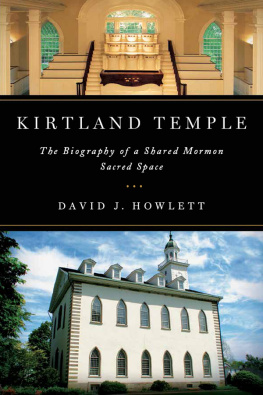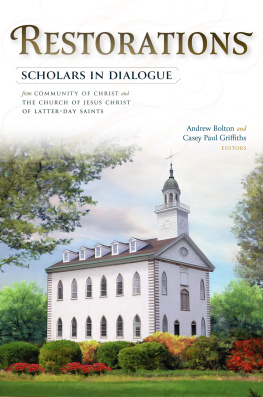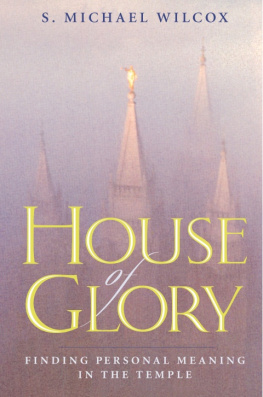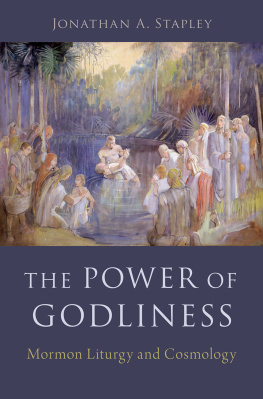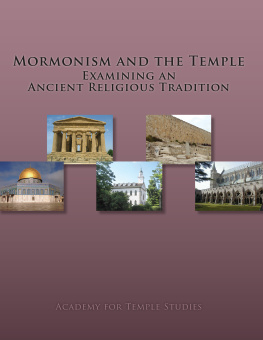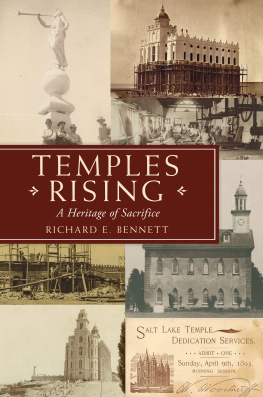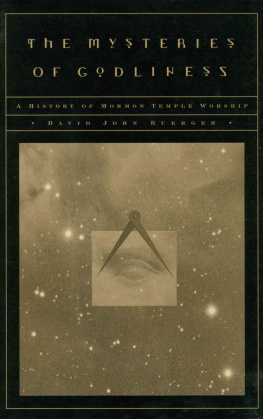DAVID J. HOWLETT is a visiting assistant professor of religion at Skidmore College.
Acknowledgments
When I was young, I occasionally would watch my handyman father work on odd projects in our basement. On one such a night, he turned from his latest project and asked me, You want to see some old-timey square nails? I nodded, and he rummaged in an old card-catalog drawer filled with odds and ends. From it, he pulled out a yellowed envelope. In pencil on the envelope's cover was written Original nails from Kirtland Temple. He opened the envelope and showed me two rusty square nails. My father's former business partner, a man who had served as a grandfather figure to me, had retrieved the nails in the 1960s while doing restoration work at the first Mormon temple, the Kirtland Temple. As a nine-year-old, I was deeply impressed by the artifactsnot just because they once belonged to my Papa, who had passed away just a few years earlier, but because I knew that the Kirtland Temple was no ordinary building. My parents, devout conservative members of the Reorganized Church of Jesus Christ of Latter Day Saints, had raised me with stories of miracles surrounding the dedication of the temple. To say that this book originated in seeing two rusty nails when I was nine is an exaggeration, but this incident illustrates that, even then, I knew something of the power of a holy site on a believer.
My study is a historical ethnography of a changing sacred site, following in the tradition of Robert Orsi, who popularized historical ethnography as a viable and important tool of inquiry for religious studies scholars.the Community of Christ Library Archives in Independence, Missouri; the Office of the Clerk of Court of the Lake County Ohio Common Pleas Court in Painesville, Ohio; and the Church History Library of the Church of Jesus Christ of Latter-day Saints in Salt Lake City, Utah. My archival sources were richly varied. They included journal entries from visitors, attendance statistics (charted monthly, revealing the faith background of pilgrims), visitor comment cards from the late 1960s and the first decade of the twenty-first century, published accounts of spiritual experiences during visits, official correspondence on the presentation and design of the site, and the scripts for plays performed at the pilgrimage site. I supplemented my study of the temple with oral history interviews, participant observation at the site, and a questionnaire. I conducted interviews of site interpreters, pilgrims, bus drivers, non-Mormon tourists, tour leaders, and long-term Kirtland residents. I also copied dozens of publicly accessed blogs that record visitor reflections about the site, many written the day after the visit. Compiling these sources meant that I incurred considerable debts of gratitude along the way.
I wish to thank my colleagues, friends, and interview partners associated (past and present) with the Kirtland Temple, Community of Christ, the Church of Jesus Christ of Latter-day Saints, Historic Kirtland, and the Lake County Common Pleas Court. These include Lachlan Mackay, Barbara Walden, Ronald Romig, Ronald G. Watt, Karl Anderson, Sunny Morton, Barbara Bernauer, Sue MacDonald, Mark Scherer, Lee Updike, Rachel Killebrew, and Maureen G. Kelly. They deserve my unbounded thanks for helping locate primary source documents, photographs, artifacts, and the occasional citation information for pesky sources that had eluded full notation in my research notes.
Writers work in communitieseven if the communities are interior imagined audiencesand those communities shape what is written. I am greatly indebted to a host of institutions, mentors, colleagues, family members, and friends who have made this book possible and shaped me as a scholar. My mentors at the University of Iowa included Raymond Mentzer, Michelene Pesantubbee, Ralph Keen, Richard Turner, Scott Schnell, Janine Sawada, Morten Schltter, and my many fellow graduate students. All of the aforementioned individuals helped inspire my interests in pilgrimage, ethnography, and religion in America. Institutions also generously supported my research and writing. Bowdoin College and the Andrew W. Mellon Foundation funded a two-year postdoctoral fellowship during which I completed this book. To these institutions, I am truly grateful to have been given the time and resources to write, revise, write, and revise.
Many more individuals have also helped me along the way. Lavina Fielding Anderson, Thomas Bremer, and Lawrence Foster read and critiqued the entire manuscript. Sam Van Horne, Pat Dolan, Rene Romig, Susanna Morrill, Royal F. W. Rhodes, Matthew Bowman, Michael Van Wagenen, Megan L. Cook, Samuel Brown, Christopher Jones, Eve Ross, and Kathryn Lofton additionally read large portions of my text. The remarkably inquisitive, bright students in my pilgrimage seminars at Kenyon College and at Bowdoin College helped me rethink key issues related to the academic study of pilgrimage. And my colleagues at Bowdoin College deserve thanks for helping me navigate my book proposal stage and contract: Elizabeth Pritchard, Robert Morrison, Jorunn Buckley, John Holt, and Matthew Klingle. Larin McLaughlin, Dawn Durante, Kevin Cunningham, and the other members of the staff at the University of Illinois Press have been incredibly patient with my project as it wended its way from a proposal to a fully revised manuscript. John Hamer generously allowed use of his wonderfully illustrated maps for this volume, and John Weese provided several of his well-executed photographs. I owe all of the aforementioned individuals far more than the rather paltry cup of coffee that I once bought Pat Dolan after he had read more than 100 pages of my text. Perhaps I should have bought Pat two cups?
Throughout my graduate career, my most significant and exacting editor and mentor was my adviser, T. Dwight Bozeman. As I began my dissertation, he was in phased retirement and was under no obligation to keep me as a student. He did keep me, though. I am a far better writer and scholar for having studied under him.
Finally, I am grateful beyond words for the support of my parents, Jim and Suzanne, and my wonderful siblings and their spouses, Julie and Nathan, Mark and Charity (and little Ethan), and Michael. It is to themand to the memory of Papathat I lovingly dedicate this book.
Appendix
Theorizing Pilgrimage
Although my study carefully defined parallel pilgrimage, the term pilgrimage itself must be given some equally thoughtful reflection. In the United States, pilgrimage as a topic of analysis came to prominence through the influential work of Victor Turner, Edith Turner, Joseph Kitagawa, and others. Similarly, from a purely pragmatic perspective, I argue that pilgrimage is for scholars to define and use. Despite its Latinate Christian origins, pilgrimage remains a useful heuristic term that brings various modern practices into a scholarly conversation that would otherwise remain separated.
Stated another way, pilgrimage is what James Clifford would call a translation term. That is, pilgrimage is a comparative concept, privileging certain originals and made for specific audiences. Any comparisons in my study that suggest that the Kirtland Temple participates in a ritual activity found at sites around the worldnamely, pilgrimagenecessarily engages in exaggerations; the trick simply lies in trying to ensure that they are disciplined.
I argue for two ways of defining pilgrimage. The first is specific and attempts to clarify why I opt for this term over religious travel or simply tourism. The second
My second definition of pilgrimage builds upon Wittgenstein's concept of family resemblances. In his posthumously published Philosophical Investigations, Wittgenstein tries to show how things can be related, more or less, without sharing any single, essential trait. Wittgenstein argues that a word like game can help describe many different practices, from tennis to chess. There is no one set of traits that these practices have in common, but they are more or less related. Theories do, too. My conceptualization of pilgrimage as a kind of family resemblance system helps us forge beyond structuralist limitations, but it is not immune from a critique of its own.

